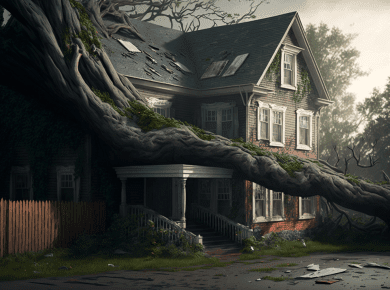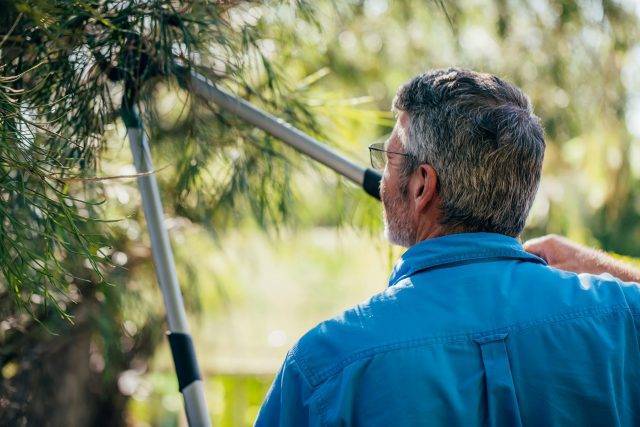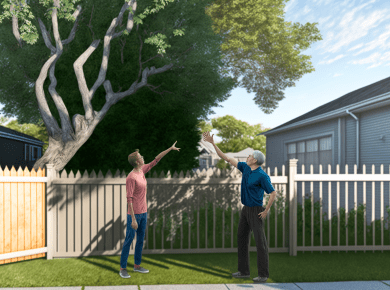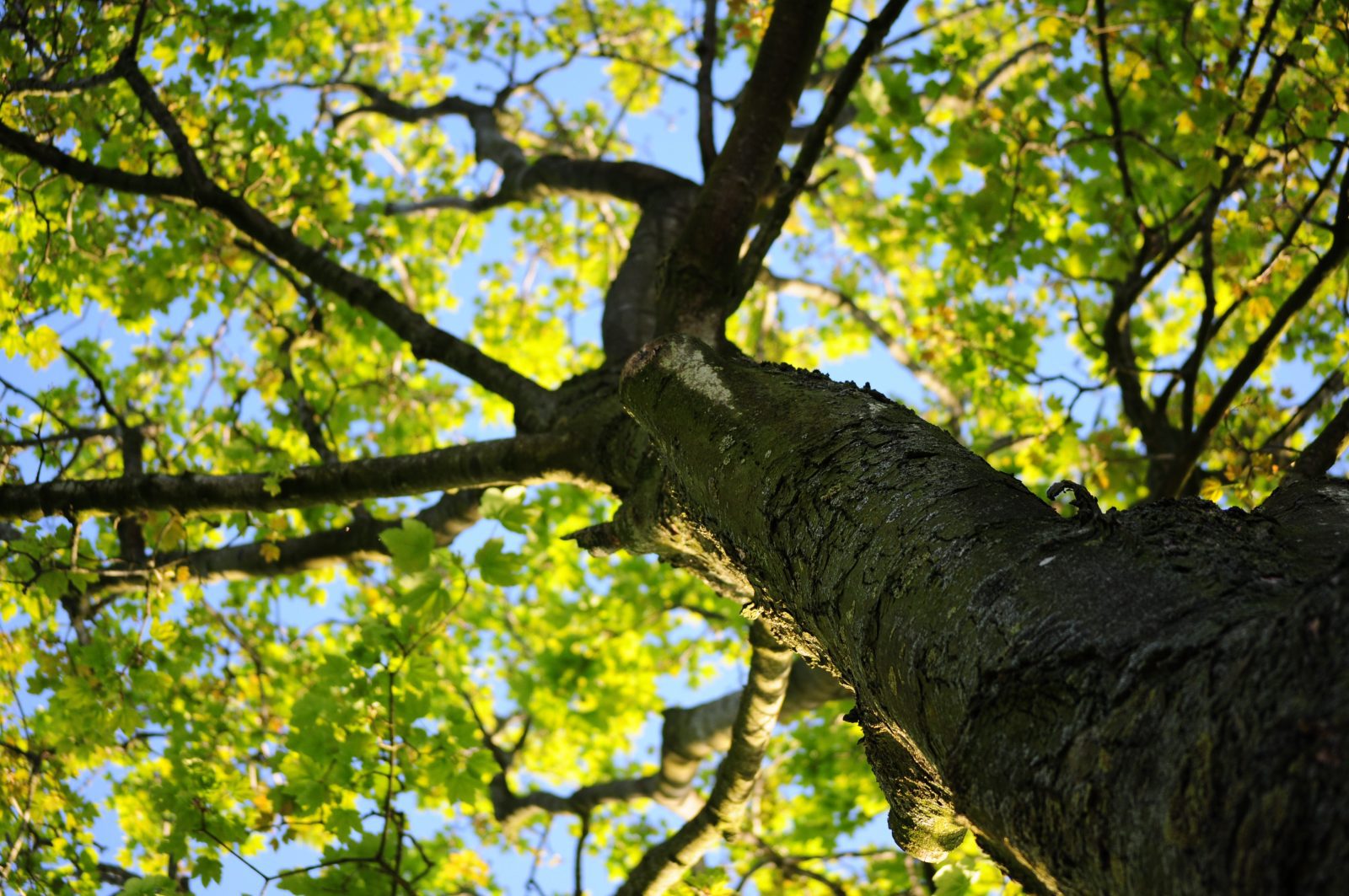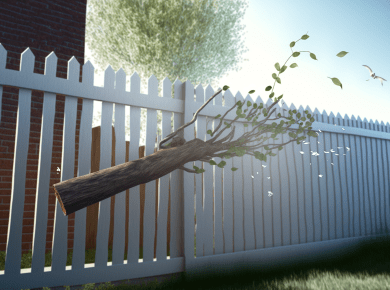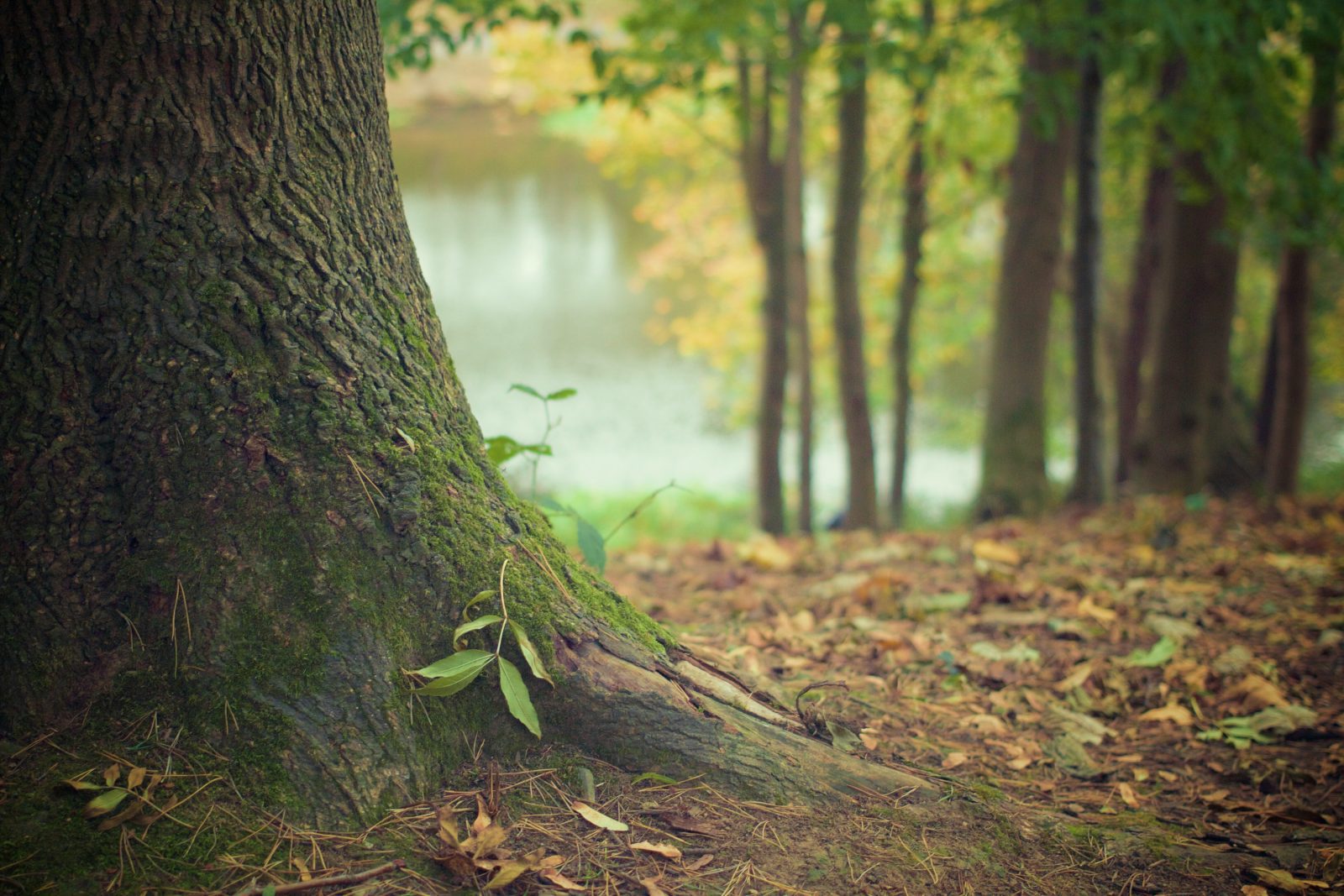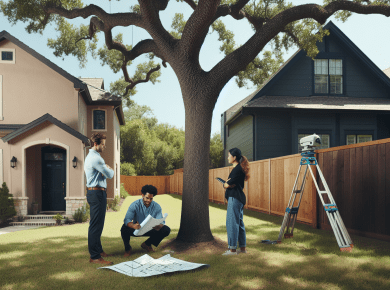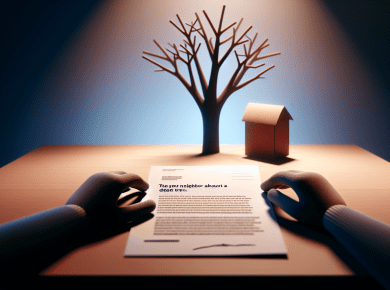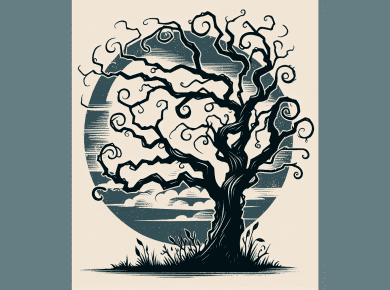Assessing the Tree’s Condition
Determining the condition of a tree is a crucial step for neighbors dealing with potential hazards or property damage related to trees. Understanding whether a tree is healthy or poses a threat will help guide the necessary actions.
Confirming the Tree’s Status
To confirm the status of a tree, one must carefully observe the physical signs that indicate its health. Common indicators that a tree may need to be removed include:
- A significant lean
- A hollow trunk
- Visible wounds or dead branches
It’s advisable to approach the neighbor in person to discuss any concerns regarding the tree and its status. Besides direct observation, neighbors should consider having a professional assessment.
- Professional inspection: It’s highly recommended to hire a certified arborist to conduct a thorough inspection of the tree. A professional can provide a clear analysis of the tree’s health and whether it needs to be removed.
Professional Inspection Recommendations
For neighbors facing issues with a questionable tree, seeking a professional inspection can aid significantly. Here are some recommended steps:
- Request an Inspection: Encourage the neighbor to hire a certified arborist for an objective assessment of the tree.
- Follow Arborist’s Recommendations: If the arborist finds that the tree is dead or poses a risk, the neighbor should consider following through with any recommended actions, such as tree removal.
- Document Findings: It’s essential to keep a record of the arborist’s findings and recommendations in case further legal action is required (Lawn Love).
By confirming the tree’s condition and seeking professional help, neighbors can address potential dangers responsibly. For assistance in communicating concerns, consider drafting a sample letter to neighbor about tree to facilitate an open discussion and document the request for an inspection or action.
Tree Management Protocols
Understanding the protocols for managing trees can help prevent disputes with neighbors and ensure safety. This section outlines strategies for mitigating the risk of falling branches and the legal aspects surrounding tree removal.
Risk Mitigation for Falling Branches
Neighbors should assess trees to identify any branches that pose a risk of falling. If there is a concern that a tree might fall and cause harm, it is advisable to coordinate efforts in trimming or cutting branches that are likely to fall onto the neighbor’s property (JustAnswer).
Legalities of Tree Removal
Legal regulations regarding tree removal vary by state. In Massachusetts, public shade trees within the public way or its boundaries are considered public property, requiring written permission from the tree warden for any actions, including cutting or trimming (Mass.gov).
In Ohio, homeowners are typically not liable for damages caused by falling trees unless it can be shown that the tree was damaged or dead and there was a clear risk of falling. Additionally, property owners have the right to clear overhanging limbs up to the property line, but must do so without causing damage or trespassing on the neighbor’s property.
For specific legal inquiries, it may be necessary to consult a local attorney or refer to local ordinances. For neighbors concerned about tree issues, drafting a sample letter to neighbor about tree or seeking mediation can be effective ways to address any tree-related disputes.
Understanding Legal Regulations
Navigating the legal landscape concerning trees and property can be complex. In this section, we will examine the regulations governing tree ownership and responsibilities in Massachusetts and Ohio.
Massachusetts Laws and Regulations
Massachusetts has specific laws regarding tree management and responsibility. According to Massachusetts law, public shade trees within the public way or its boundaries are considered public property until proven otherwise. These trees cannot be cut, trimmed, or removed without written permission from the tree warden (Mass.gov). Violators who damage these trees may face imprisonment for up to six months or a fine of up to $500. Furthermore, those who engage in willful trespass to trees may be liable for damages assessed at three times the amount of the damage (Mass.gov).
Additionally, under Massachusetts law:
| Violation Type | Penalty |
|---|---|
| Cutting or destroying timber on another’s land | Fine or imprisonment for willful destruction |
| Damage to trees of another person | Imprisonment for up to six months or a $500 fine |
Legal responsibility for tree-related damage during storm events lies with the property owner where the damage occurred, regardless of whether the tree was on their property or theirs alone (Massachusetts fallen tree law, Mass. Real Estate Blog).
Ohio Laws and Considerations
Ohio law also addresses tree-related issues, particularly concerning damage and removal. Damaging a tree on another person’s property without permission is considered a fourth-degree misdemeanor in Ohio, which may carry penalties of up to $250 and/or 30 days in jail. Violators can also be subject to damages that are up to three times the value of the harmed tree.
In terms of liability, Ohio law typically states:
Property owners are not liable for damages caused by a falling tree unless they had prior knowledge of the potential risk of the tree falling due to damage, disease, or being dead.
The law remains unclear as to whether landowners can remove trees that are located on property lines without neighbor permission. It is advisable for neighbors to discuss the removal beforehand, addressing payment for the tree’s removal and disposal of debris.
For anyone experiencing issues with trees, it may be beneficial to draft a sample letter to neighbor about tree to formally communicate concerns.
Addressing Property Damage
When tree-related issues arise, determining responsibility for any resulting damage is crucial for resolving disputes effectively. Understanding the rights and obligations can help neighbors navigate these complex situations.
Legally, responsibility for damage caused by a tree often lies with the property owner where the damage occurred, irrespective of the tree’s origin Massachusetts Law. This means if a tree from a neighbor’s property falls and damages your home, the neighbor could potentially be liable for damages.
Consider the following situations regarding tree-related harm:
| Scenario | Responsibility |
|---|---|
| Tree falls from neighbor’s property during a storm | Neighbor’s property owner may bear responsibility |
| Neighbor’s dead tree causes damage | Neighbor could be held liable if negligence is proven |
| Branches from neighbor’s tree cause damage | Neighbor may be responsible, depending on circumstances |
Documentation of any damage is essential. Neighbors should take clear photographs of the damage and the position of the tree to support their claims if legal action becomes necessary. For additional guidance on documenting damages, see our article on how to determine if a tree is on your property.
Resolving Disputes and Issues
When a tree from a neighbor’s property poses a risk or has already caused damage, open communication is key. Initially discussing concerns with the neighbor can lead to a mutually agreeable solution. If informal discussions fail, a more formal approach may be required.
In such cases, neighbors might consider sending a well-crafted letter detailing concerns and legal implications. This letter can serve several purposes:
- It establishes a written record of communication.
- It outlines the potential legal ramifications of not addressing the tree issue. If the tree is found to be hazardous, a neighbor can be encouraged to hire a certified arborist for an inspection, as suggested in the extra context.
- It provides evidence of neighbor negligence if further action is needed later.
For assistance in drafting such communication, refer to our example of a letter to neighbor about tree. If disputes persist after addressing the issue amicably and legally, pursuing a formal legal action may be required. In some cases, neighbors may opt to seek a nuisance claim in court to compel a neighbor to remove a hazardous tree, ensuring their property remains safe.
Understanding responsibilities and effective communication can lead to resolution and preserve good neighborly relations. If further assistance is needed, exploring articles on can you sue someone for cutting down trees on your property and neighbor cut down trees on my property could provide additional insights.
Legal Actions and Documentation
When dealing with issues related to trees and neighboring properties, it may become necessary to take formal legal action. This section will cover how to craft a formal letter and outline steps for pursuing legal recourse.
Crafting a Formal Letter
A well-structured letter to a neighbor can serve as both a formal notice and a record of communication concerning the tree issue. The letter should clearly outline concerns regarding the tree’s condition and pose any requests for action. It is vital to detail the potential consequences if the issues remain unaddressed, including the possibility of taking legal action. This step is especially important if a neighbor is uncooperative after discussions and inspection requests, as a formal letter may motivate them to take the necessary actions. The letter will also serve as evidence in case of property damage caused by the tree and neighbor negligence (Lawn Love).
A sample structure for the letter might include:
| Section | Content |
|---|---|
| Salutation | Address the neighbor politely. |
| Introduction | Briefly explain the reason for writing. |
| Concerns | Describe the state of the tree and any damage it may have caused. |
| Requests | Clearly state what action is expected from the neighbor (e.g., inspection, pruning, or removal). |
| Consequences | Mention possible legal actions if no resolution is reached. |
| Closing | Politely thank them for their attention to the matter. |
For more guidance on correspondences related to trees, see our sample letter to neighbor about tree.
Pursuing Legal Recourse
If efforts to resolve the tree issue amicably do not yield results, pursuing legal action may be the next option. Legal action can be undertaken when a neighbor does not adhere to requests for tree removal or continues to allow a hazardous tree to pose a threat to property and safety. This may involve filing a nuisance claim in court to compel the neighbor to remove the tree (Lawn Love).
In addition, if a neighbor’s tree causes damage to the property, documenting the damage is critical. This includes taking pictures that show both the damage and the condition and location of the neighbor’s tree in relation to the property. Such documentation can be advantageous when holding the neighbor responsible for the damages.
Ultimately, legal responsibility often varies, especially during storms, as the liability for a fallen tree typically lies with the property owner where the damage occurs, regardless of the tree’s origin. In cases where agreements cannot be reached about costs for repairs of damages caused by trees, neighbors may need to file complaints with local authorities or seek judicial intervention (Ohio Farm Bureau).
Being informed about these aspects related to trees and property can empower neighbors to address their concerns more effectively and to take appropriate legal steps if necessary.
Tree Preservation Orders
Overview of Tree Preservation Orders
Tree Preservation Orders (TPOs) are legal tools established by local planning authorities in England to protect specific trees, groups of trees, or woodlands for the public’s benefit. These orders prohibit certain activities, such as cutting down or damaging protected trees, without obtaining prior written consent from the local planning authority (GOV.UK Tree Preservation Orders). TPOs can apply to individual trees, trees within an area, groups of trees, or entire woodlands, ensuring the safeguarding of trees and saplings even if they naturally grow after the order’s establishment.
Key Features of Tree Preservation Orders:
| Feature | Description |
|---|---|
| Protects Trees | Safeguards specific trees or groups of trees from harm |
| Consent Requirement | Requires permission for any work that may affect protected trees |
| Owner Responsibility | Owners must maintain protected trees according to best practices |
| Covers Varied Sizes | Can protect trees of any size or species |
| Excludes Shrubs and Hedges | Typically does not cover shrubs and hedges |
Local planning authorities have the responsibility to create and enforce TPOs based on the trees’ importance to the local environment. These authorities consider the trees’ contribution to local amenity when deciding on protection measures.
Rights and Responsibilities for Tree Protection
With the implementation of Tree Preservation Orders, both property owners and local authorities have specific rights and responsibilities. The act of protecting trees is not only a legal obligation but also plays a vital role in maintaining ecological balance and enhancing the local landscape.
Responsibilities of Tree Owners:
- Maintain the health of protected trees using good management practices.
- Seek permission from local authorities before undertaking any work that might impact the trees (GOV.UK Tree Preservation Orders).
Rights of Tree Owners:
- Request a review of the Tree Preservation Order if they believe it is no longer warranted, especially if land use circumstances have changed.
- Challenge any enforcement action taken by local authorities regarding alleged breaches of the TPOs.
If a neighbor has cut down or damaged a tree that may be under a TPO, affected individuals may wish to draft a sample letter to neighbor about tree to address their concerns. Understanding both the rights and responsibilities related to TPOs ensures that neighbors can effectively manage issues concerning trees on or near their property.

